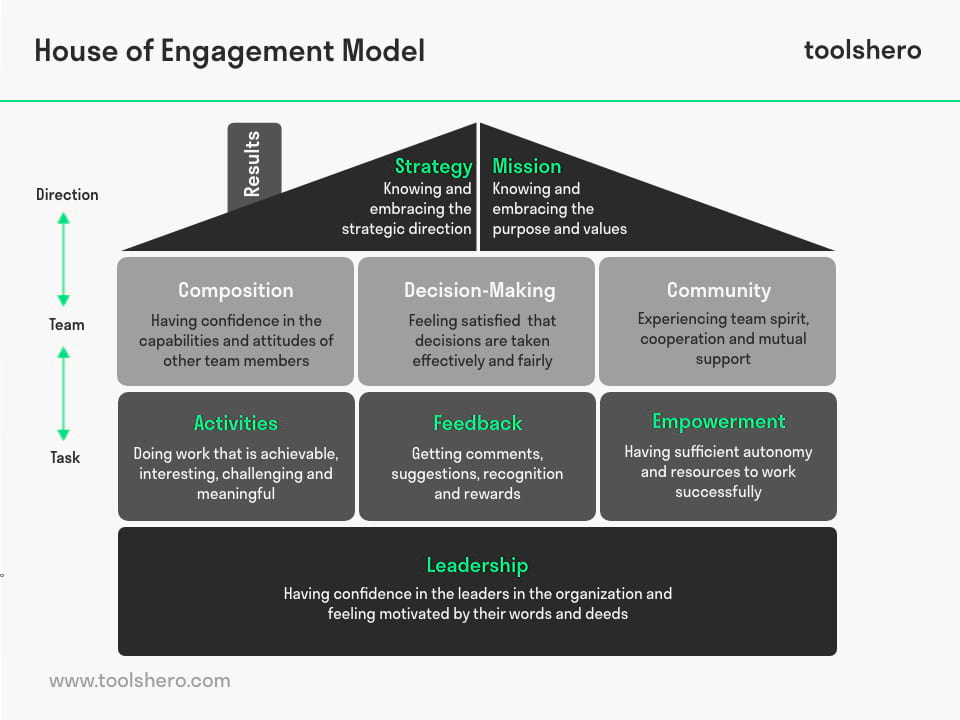House of Engagement

Which factors can contribute to higher engagement in my organization?
Key Definitions
People are engaged if they feel connected to their organization and are motivated to contribute to its success. So, becoming engaged is about emotional bonding – buying in to an organization and developing the desire to help it achieve its objectives.
Just as with a couple or an engine clutch, engagement is the process of bringing two sides together in a fruitful way. Employees can seek to become more engaged, while at the same time managers can try to engage employees by winning hearts and minds in a variety of ways.
Conceptual Model
The House of Engagement summarizes the ten most important areas in which managers can find factors that will win the hearts and minds of people in the organization. This checklist of engagement factors is divided into four general categories that metaphorically resemble a house.
The ‘ground floor’ of engagement is determined by the nature of the task environment in which people work, while the ‘upper floor’ is shaped by the team in which they work. The overarching roof is formed by the direction the organization is pursuing, while the basement on which the entire house rest is the leadership of the organization.
Key Elements
The ten parts of the House of Engagement are:
- Activities. The ‘front door’ of engagement is ensuring that people feel motivated by the very work they do. Common factors that contribute to engagement are activities that are achievable, interesting, challenging and meaningful.
- Feedback. People can also be engaged by the amount and type of feedback that they get on their activities. This includes compliments, comments, suggestions, recognition, compensation, rewards and even just seeing the results of their activities.
- Empowerment. Having sufficient power to get activities done and achieve results is also key to engagement. This includes having the autonomy and liberty to make choices, as well as the authority, capabilities and resources to implement these choices.
- Composition. Working with a well-selected group of people, who all know which role to play, can also be very engaging. A good composition includes having people with the right capabilities and attitudes in the right positions, while the whole is nicely balanced.
- Decision-Making. People also want to have confidence in how decisions are made. It can be very engaging if the decision-making process is qualitatively good and fair, decisions are well-communicated and implementation quickly follows.
- Community. It is also very engaging to work with a group of people who pull together as a team, establishing a shared sense of community. Key elements here include experiencing mutual respect and trust, cooperation, ongoing support and team spirit.
- Strategy. Understanding and believing in the organization’s strategy can also be essential to engagement. Even more so if people have been involved in developing the strategy and know how they can contribute to its implementation.
- Mission. Likewise, believing in the mission of the organization can be highly engaging. If the purpose of the organization is appealing, its values inspiring, and it walks the talk, people can be infused with a “missionary” zeal to make the organization a success.
- Results. Achieving great results can be engaging in itself. Whether it is reaching a level of performance or creating value for clients and society, being successful at what you set out to do can fill people with pride and the drive to carry on.
- Leadership. Having managers who are felt to be effective leaders is the essential basis for engagement. Where people feel supported and inspired by all levels of management, and have confidence in them, people will willingly follow and feel highly engaged.
Key Insights
- More than satisfaction or motivation. Engagement is about getting people to buy in to the organization. Employees who get a day off might be satisfied, those who get a performance bonus might be motivated, but neither act is engaging, as neither contributes to building an emotional bond and winning people over to make the organization a success.
- Engagement is a key management task. It takes two sides to become engaged, but managers are best placed to create the conditions that will lead to winning the hearts and minds of people in the organization.
- Engagement has ten main dimensions. Engagement is complex. Many factors will influence people’s emotional commitment to the organization, but they fall into ten categories, varying from enjoying everyday activities to embracing the mission.
- Engagement drivers differ per person. While the ten categories of engagement factors are universal, the relative importance of each category and the specific driver in each category differ from person to person, as well as over time and shifting circumstances.
- Engagement needs to be monitored. Knowing the engagement drivers per person in each of the ten categories gives managers excellent insight to improve engagement. A corporate engagement score generally does not give the right level of detail.
How to cite this article:
Meyer, R. (2019). House of Engagement. Retrieved [insert date] from toolshero: https://www.toolshero.com/management/house-of-engagement/
Add a link to this page on your website:
<a href=”https://www.toolshero.com/management/house-of-engagement/”>toolshero: House of Engagement</a>













